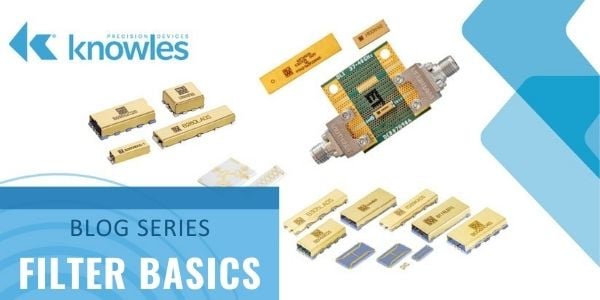Introduction to Filters
The goal of our filter basics series is to provide more information about how filters function to help guide your filter selection process.
To help customers with filter selection, we generally provide a lot of information on what our filters can do. But in this new Filter Basics Series, we are taking a step back to cover some background information on how filters do what they do. Regardless of the technology behind the filter, there are several key concepts that all filters share that we will dive into throughout this series. By providing this detailed fundamental filter information, we hope to help you simplify your future filtering decisions.

Table of Contents
Part 1: Resistance, Capacitance, Inductance, and Impedance
This post breaks down the basic properties impacting capacitor and inductor performance including resistance, inductance, and impedance.
Part 2: Designing Basic Filter Circuits
In part 2, we cover how RF designers can use the different frequency dependencies of capacitors and inductors to manipulate impedance and create various filter responses.
Part 3: Five Key Filter Specifications to Understand
In part 3 we aim to help simplify filter selection by providing an overview and reference point for five of the most commonly discussed filter technology specifications.
Part 4: Key Filter Types and Technologies
In part 4 of this series we provide overviews of the main filter types and key filter technologies available today.
Part 5: Lumped Element and Distributed Element Filter Construction
Part 5 dives into more detail on lumped element and distributed element filter construction techniques and when each option is most appropriate to use based on your application.
Part 6: Waveguides and Transmission Lines
Part 6 expands on part 5 by covering more details on waveguides and transmission lines, including the different types of electromagnetic modes supported by each.
Part 7: Different Approaches to Q Factor
Part 7 provides a deep dive on the different ways to think about Q factor for the components going into your filter or your filter as a whole.
Part 8: An In-Depth Look at Bandwidth
In part 8, we dive deeper into bandwidth by looking at the history of bandwidth, how bandwidth dictates data rate, and why the type of filter required will vary depending on an application’s bandwidth requirements.
Part 9: An Introduction to Poles and Zeros
In part 9, we go in-depth on the background information of how poles and zeros impact a transfer function to show you how you can use this information to improve your filter’s performance.
Part 10: Resonators as Microwave Devices
In part 10 we discuss how resonators function as a microwave device and dive deeper into specifications for ceramic coaxial and dielectric resonators specifically.
Part 11: What Are S Parameters and What Can They Tell Us About a Filter?
In part 11, the last post in our Filter Basics series, we review the information S-parameters can tell you about a filter’s performance and show an example of how to plot a filter’s S-parameters using a free open-source tool.

.webp?width=313&height=157&name=Knowles%20Social%20Graphics%20(7).webp)

